transmission JEEP WRANGLER 2012 JK / 3.G Owner's Manual
[x] Cancel search | Manufacturer: JEEP, Model Year: 2012, Model line: WRANGLER, Model: JEEP WRANGLER 2012 JK / 3.GPages: 124, PDF Size: 5.48 MB
Page 90 of 124
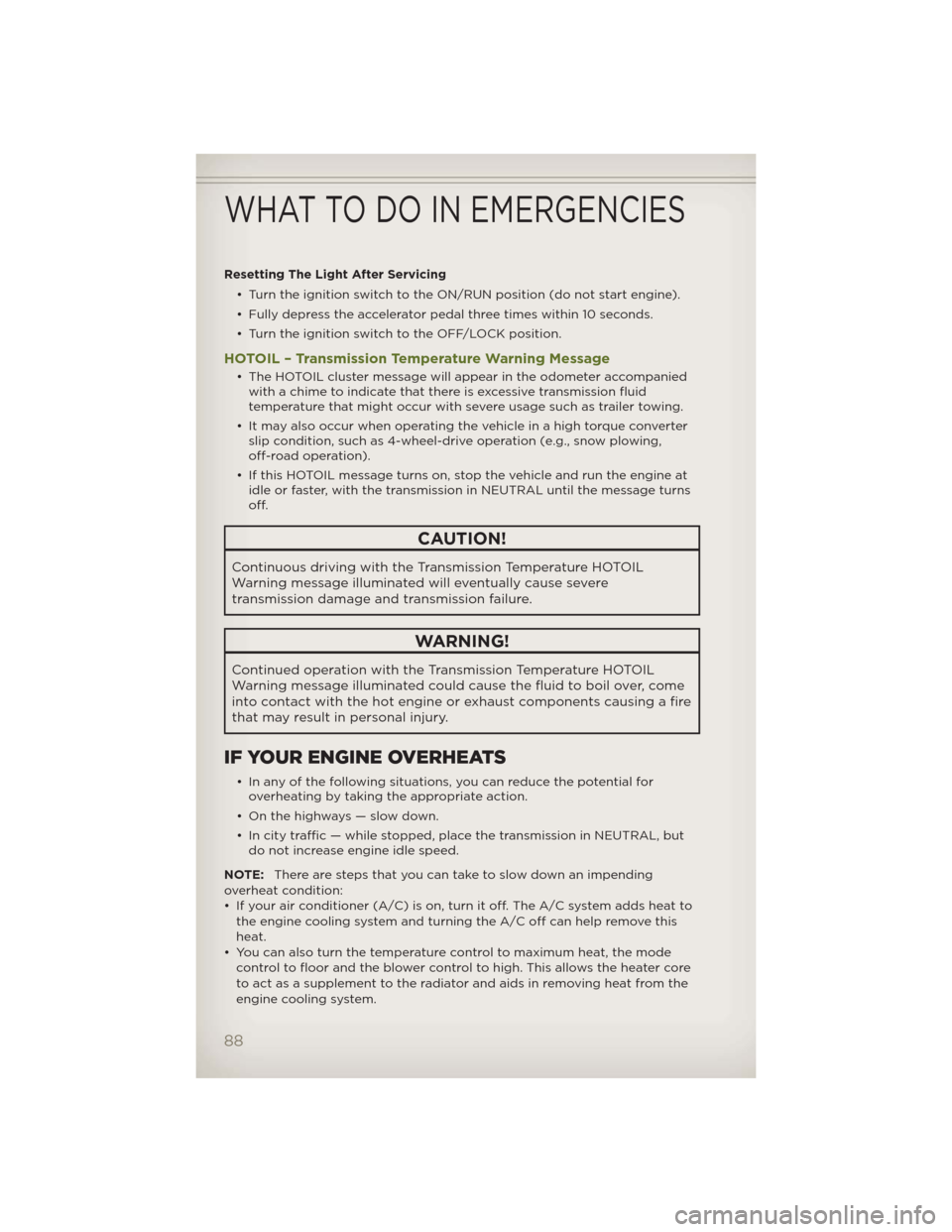
Resetting The Light After Servicing
• Turn the ignition switch to the ON/RUN position (do not start engine).
• Fully depress the accelerator pedal three times within 10 seconds.
• Turn the ignition switch to the OFF/LOCK position.
HOTOIL – Transmission Temperature Warning Message
• The HOTOIL cluster message will appear in the odometer accompanied
with a chime to indicate that there is excessive transmission fluid
temperature that might occur with severe usage such as trailer towing.
• It may also occur when operating the vehicle in a high torque converter
slip condition, such as 4-wheel-drive operation (e.g., snow plowing,
off-road operation).
• If this HOTOIL message turns on, stop the vehicle and run the engine at
idle or faster, with the transmission in NEUTRAL until the message turns
off.
CAUTION!
Continuous driving with the Transmission Temperature HOTOIL
Warning message illuminated will eventually cause severe
transmission damage and transmission failure.
WARNING!
Continued operation with the Transmission Temperature HOTOIL
Warning message illuminated could cause the fluid to boil over, come
into contact with the hot engine or exhaust components causing a fire
that may result in personal injury.
IF YOUR ENGINE OVERHEATS
• In any of the following situations, you can reduce the potential for
overheating by taking the appropriate action.
• On the highways — slow down.
• In city traffic — while stopped, place the transmission in NEUTRAL, but
do not increase engine idle speed.
NOTE:There are steps that you can take to slow down an impending
overheat condition:
• If your air conditioner (A/C) is on, turn it off. The A/C system adds heat to
the engine cooling system and turning the A/C off can help remove this
heat.
• You can also turn the temperature control to maximum heat, the mode
control to floor and the blower control to high. This allows the heater core
to act as a supplement to the radiator and aids in removing heat from the
engine cooling system.
WHAT TO DO IN EMERGENCIES
88
Page 92 of 124
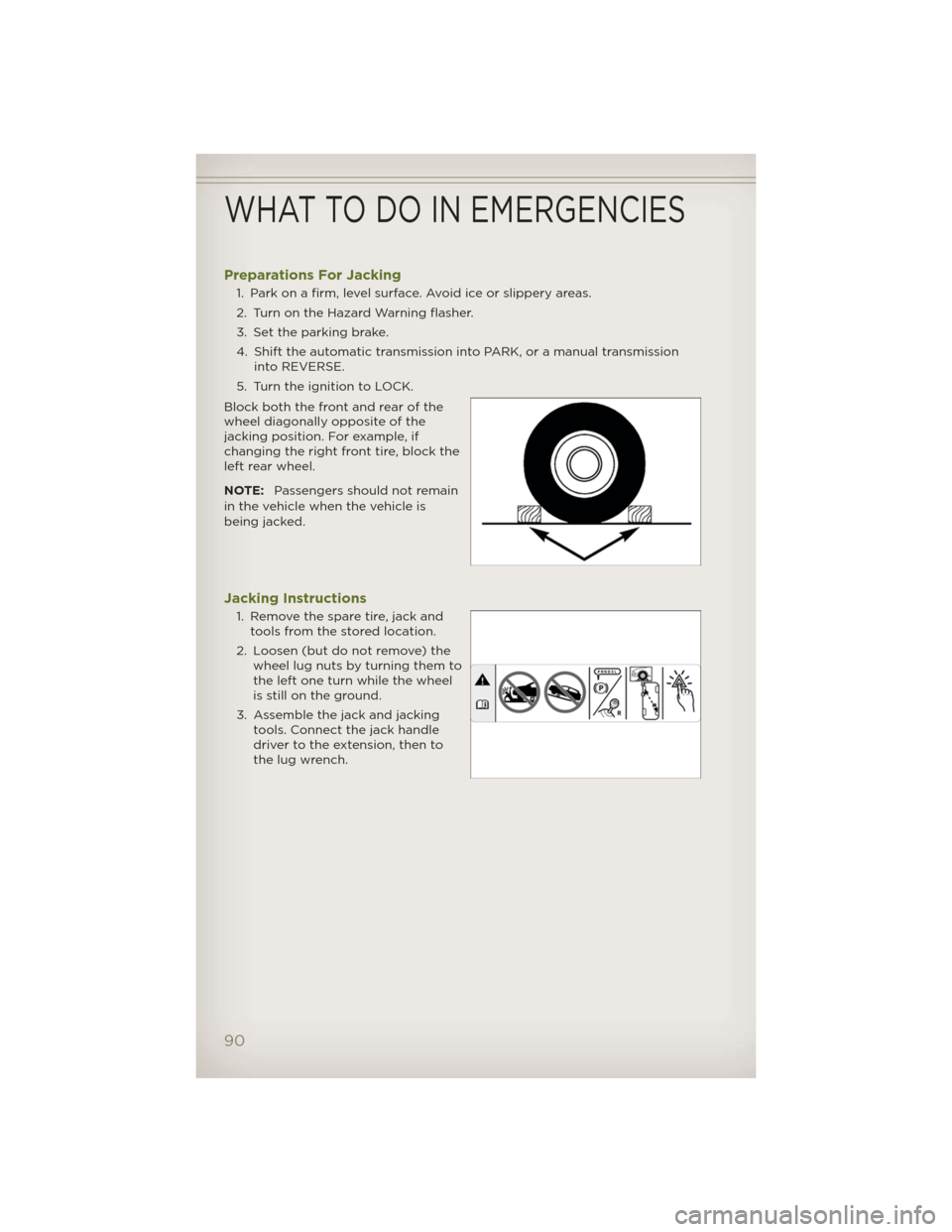
Preparations For Jacking
1. Park on a firm, level surface. Avoid ice or slippery areas.
2. Turn on the Hazard Warning flasher.
3. Set the parking brake.
4. Shift the automatic transmission into PARK, or a manual transmission
into REVERSE.
5. Turn the ignition to LOCK.
Block both the front and rear of the
wheel diagonally opposite of the
jacking position. For example, if
changing the right front tire, block the
left rear wheel.
NOTE:Passengers should not remain
in the vehicle when the vehicle is
being jacked.
Jacking Instructions
1. Remove the spare tire, jack and
tools from the stored location.
2. Loosen (but do not remove) the
wheel lug nuts by turning them to
the left one turn while the wheel
is still on the ground.
3. Assemble the jack and jacking
tools. Connect the jack handle
driver to the extension, then to
the lug wrench.
WHAT TO DO IN EMERGENCIES
90
Page 94 of 124
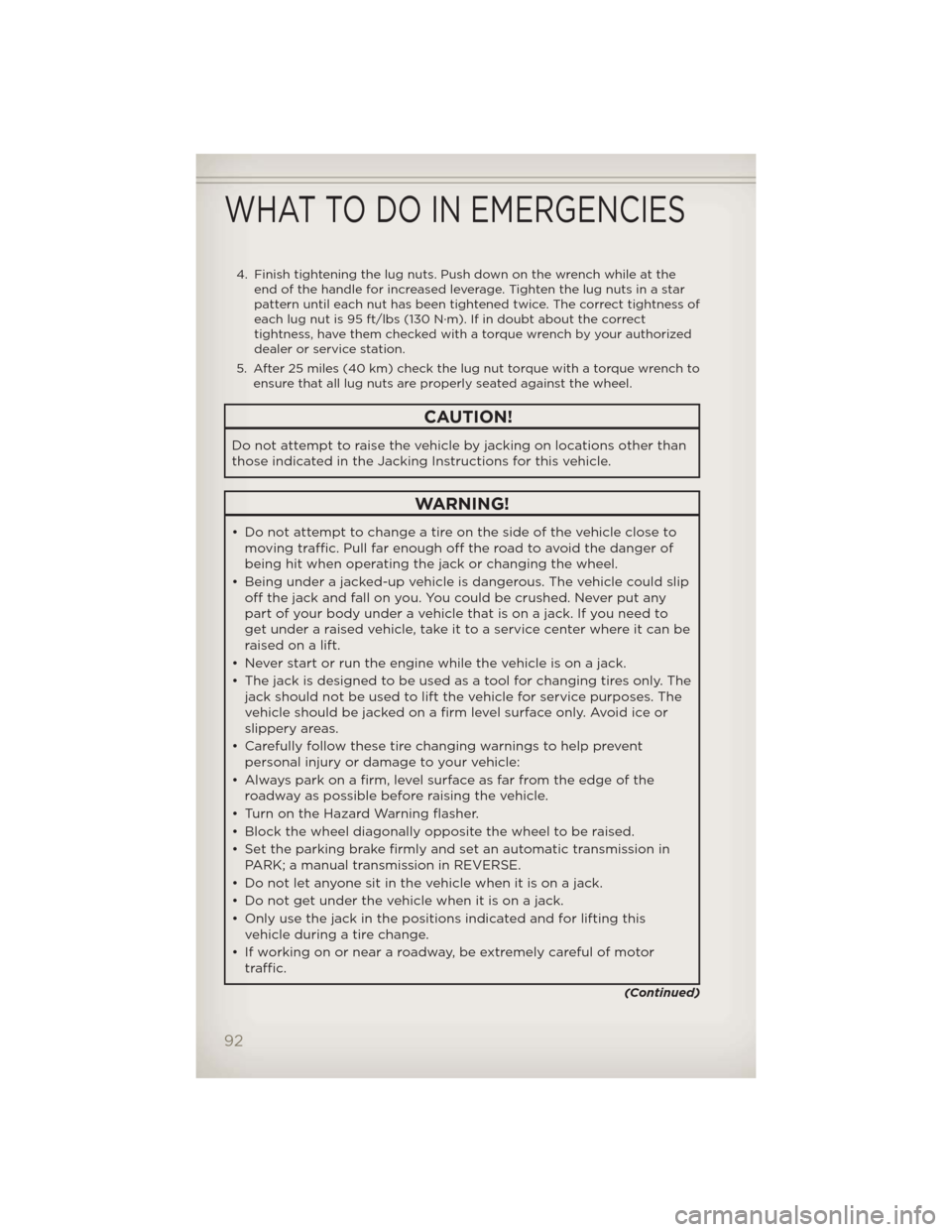
4. Finish tightening the lug nuts. Push down on the wrench while at the
end of the handle for increased leverage. Tighten the lug nuts in a star
pattern until each nut has been tightened twice. The correct tightness of
each lug nut is 95 ft/lbs (130 N·m). If in doubt about the correct
tightness, have them checked with a torque wrench by your authorized
dealer or service station.
5. After 25 miles (40 km) check the lug nut torque with a torque wrench to
ensure that all lug nuts are properly seated against the wheel.
CAUTION!
Do not attempt to raise the vehicle by jacking on locations other than
those indicated in the Jacking Instructions for this vehicle.
WARNING!
• Do not attempt to change a tire on the side of the vehicle close to
moving traffic. Pull far enough off the road to avoid the danger of
being hit when operating the jack or changing the wheel.
• Being under a jacked-up vehicle is dangerous. The vehicle could slip
off the jack and fall on you. You could be crushed. Never put any
part of your body under a vehicle that is on a jack. If you need to
get under a raised vehicle, take it to a service center where it can be
raised on a lift.
• Never start or run the engine while the vehicle is on a jack.
• The jack is designed to be used as a tool for changing tires only. The
jack should not be used to lift the vehicle for service purposes. The
vehicle should be jacked on a firm level surface only. Avoid ice or
slippery areas.
• Carefully follow these tire changing warnings to help prevent
personal injury or damage to your vehicle:
• Alwayspark on a firm, level surface as far from the edge of the
roadway as possible before raising the vehicle.
• Turn on the Hazard Warning flasher.
• Block the wheel diagonally opposite the wheel to be raised.
• Set the parking brake firmly and set an automatic transmission in
PARK; a manual transmission in REVERSE.
• Do not let anyone sit in the vehicle when it is on a jack.
• Do not get under the vehicle when it is on a jack.
• Only use the jack in the positions indicated and for lifting this
vehicle during a tire change.
• If working on or near a roadway, be extremely careful of motor
traffic.
(Continued)
WHAT TO DO IN EMERGENCIES
92
Page 95 of 124
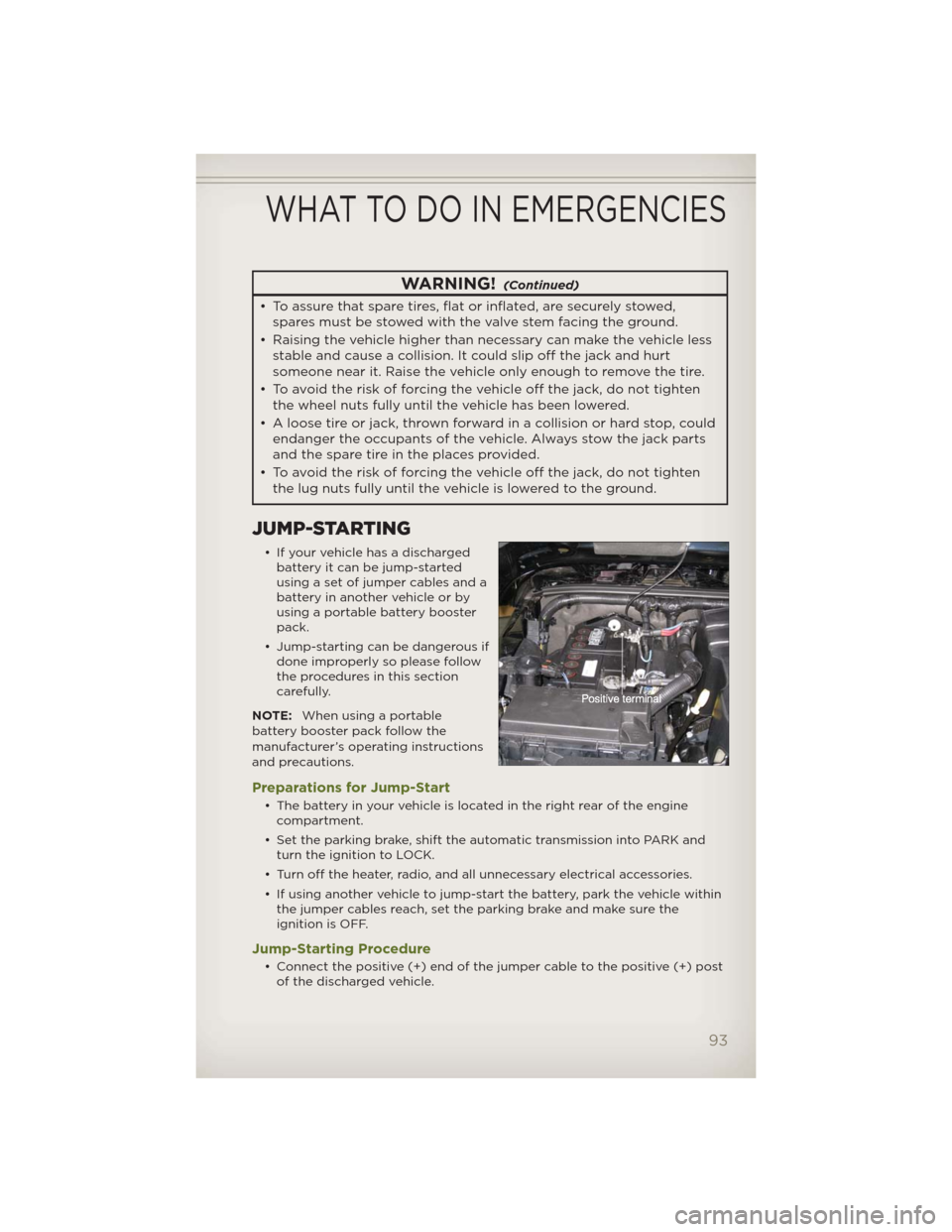
WARNING!(Continued)
• To assure that spare tires, flat or inflated, are securely stowed,
spares must be stowed with the valve stem facing the ground.
• Raising the vehicle higher than necessary can make the vehicle less
stable and cause a collision. It could slip off the jack and hurt
someone near it. Raise the vehicle only enough to remove the tire.
• To avoid the risk of forcing the vehicle off the jack, do not tighten
the wheel nuts fully until the vehicle has been lowered.
• A loose tire or jack, thrown forward in a collision or hard stop, could
endanger the occupants of the vehicle. Always stow thejack parts
and the spare tire in the places provided.
• To avoid the risk of forcing the vehicle off the jack, do not tighten
the lug nuts fully until the vehicle is lowered to the ground.
JUMP-STARTING
• If your vehicle has a discharged
battery it can be jump-started
using a set of jumper cables and a
battery in another vehicle or by
using a portable battery booster
pack.
• Jump-starting can be dangerous if
done improperly so please follow
the procedures in this section
carefully.
NOTE:When using a portable
battery booster pack follow the
manufacturer’s operating instructions
and precautions.
Preparations for Jump-Start
• The battery in your vehicle is located in the right rear of the engine
compartment.
• Set the parking brake, shift the automatic transmission into PARK and
turn the ignition to LOCK.
• Turn off the heater, radio, and all unnecessary electrical accessories.
• If using another vehicle to jump-start the battery, park the vehicle within
the jumper cables reach, set the parking brake and make sure the
ignition is OFF.
Jump-Starting Procedure
• Connect the positive (+) end of the jumper cable to the positive (+) post
of the discharged vehicle.
WHAT TO DO IN EMERGENCIES
93
Page 98 of 124
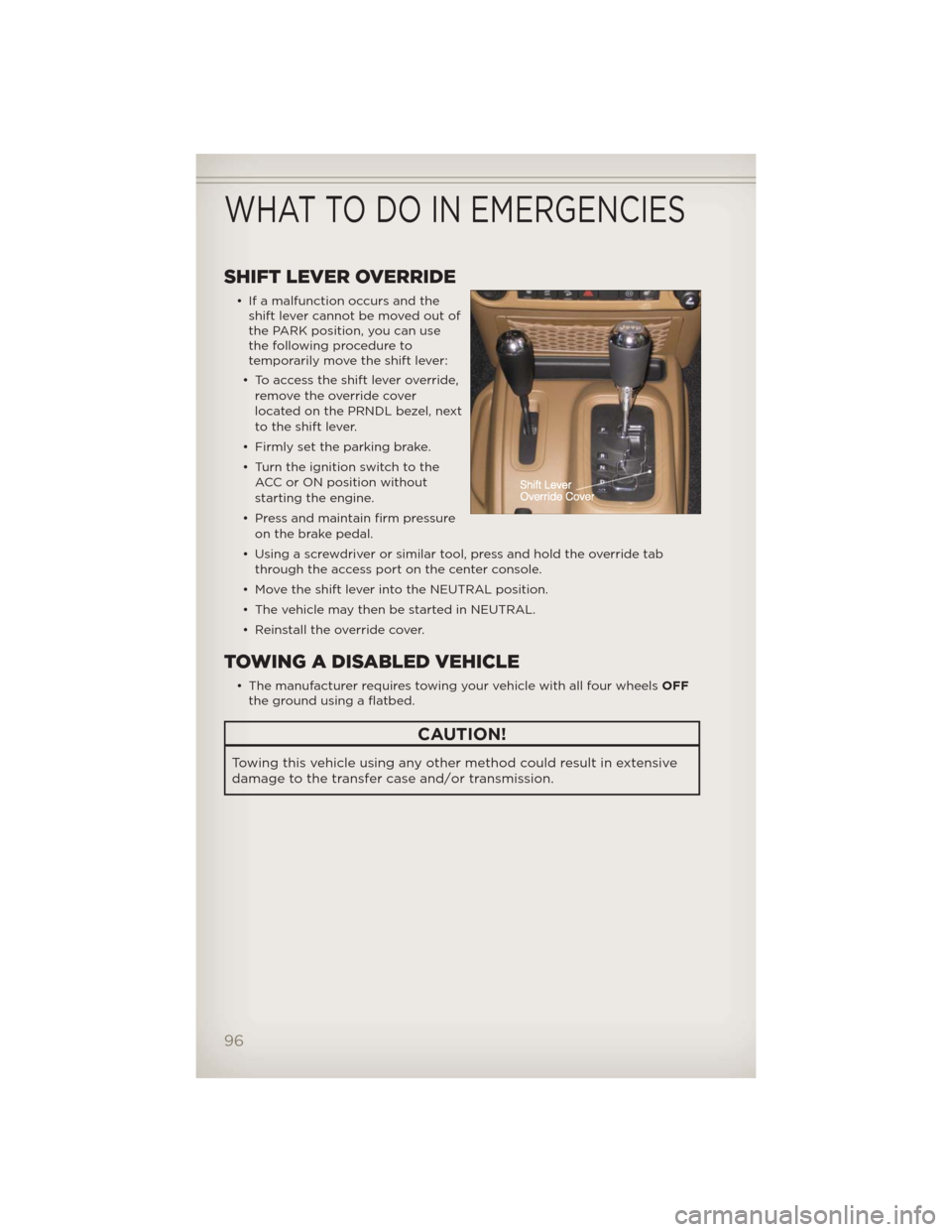
SHIFT LEVER OVERRIDE
• If a malfunction occurs and the
shift lever cannot be moved out of
the PARK position, you can use
the following procedure to
temporarily move the shift lever:
• To access the shift lever override,
remove the override cover
located on the PRNDL bezel, next
to the shift lever.
• Firmly set the parking brake.
• Turn the ignition switch to the
ACC or ON position without
starting the engine.
• Press and maintain firm pressure
on the brake pedal.
• Using a screwdriver or similar tool, press and hold the override tab
through the access port on the center console.
• Move the shift lever into the NEUTRAL position.
• The vehicle may then be started in NEUTRAL.
• Reinstall the override cover.
TOWING A DISABLED VEHICLE
• The manufacturer requires towing your vehicle with all four wheelsOFF
the ground using a flatbed.
CAUTION!
Towing this vehicle using any other method could result in extensive
damage to the transfer case and/or transmission.
WHAT TO DO IN EMERGENCIES
96
Page 99 of 124
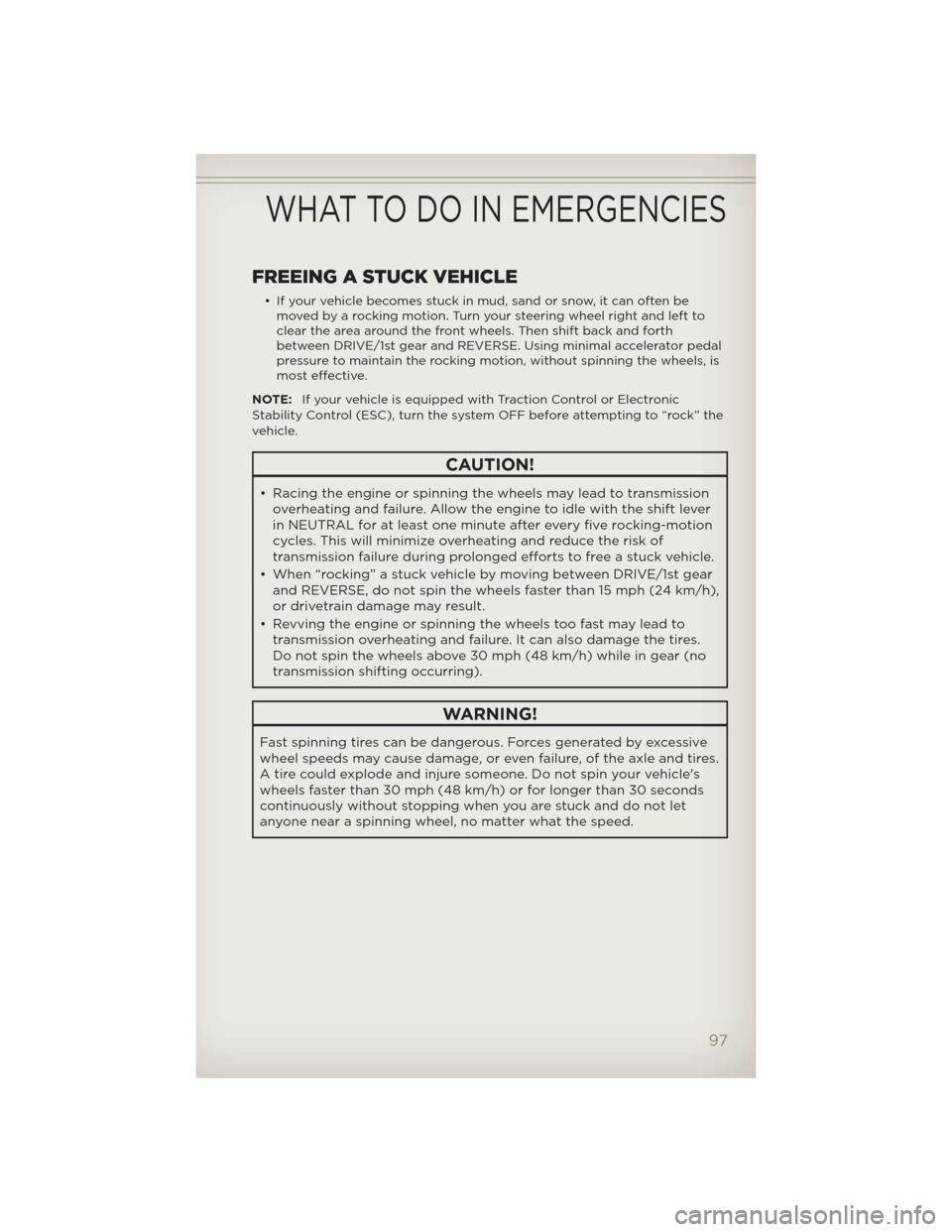
FREEING A STUCK VEHICLE
• If your vehicle becomes stuck in mud, sand or snow, it can often be
moved by a rocking motion. Turn your steering wheel right and left to
clear the area around the front wheels. Then shift back and forth
between DRIVE/1st gear and REVERSE. Using minimal accelerator pedal
pressure to maintain the rocking motion, without spinning the wheels, is
most effective.
NOTE:If your vehicle is equipped with Traction Control or Electronic
Stability Control (ESC), turn the system OFF before attempting to “rock” the
vehicle.
CAUTION!
• Racing the engine or spinning the wheels may lead to transmission
overheating and failure. Allow the engine to idle with the shift lever
in NEUTRAL for at least one minute after every five rocking-motion
cycles. This will minimize overheating and reduce the risk of
transmission failure during prolonged efforts to free a stuck vehicle.
• When “rocking” a stuck vehicle by moving between DRIVE/1st gear
and REVERSE, do not spin the wheels faster than 15 mph (24 km/h),
or drivetrain damage may result.
• Revving the engine or spinning the wheels too fast may lead to
transmission overheating and failure. It can also damage the tires.
Do not spin the wheels above 30 mph (48 km/h) while in gear (no
transmission shifting occurring).
WARNING!
Fast spinning tires can be dangerous. Forces generated by excessive
wheel speeds may cause damage, or even failure, of the axle and tires.
A tire could explode and injure someone. Do not spin your vehicle's
wheels faster than 30 mph (48 km/h) or for longer than 30 seconds
continuously without stopping when you are stuck and do not let
anyone near a spinning wheel, no matter what the speed.
WHAT TO DO IN EMERGENCIES
97
Page 103 of 124

FLUIDS AND CAPACITIES
ComponentFluid, Lubricant, or
Genuine PartCapacities
Engine Coolant 3.6L MOPAR® Antifreeze/
Coolant 5
Year/100,000 Mile
Formula HOAT (Hybrid
Organic Additive
Technology) or
equivalent.10.5 Quarts (9.9 Liters)
Includes coolant
recovery bottle filled to
MAX level.
Engine Oil with filter
3.6LUse API Certified SAE
5W-30 Engine Oil,
meeting the
requirements of
Chrysler Material
Standard MS-6395.
Refer to your engine oil
filler cap for correct
SAE grade.6 quarts (5.7 Liters)
Engine Oil Filter 3.6L MOPAR® Engine Oil
Filter or equivalent.—
Spark Plug 3.6L RER8ZWYCB4 (Gap
0.043 in [1.1 mm])—
Automatic Transmission MOPAR® ATF+4®
Automatic Transmission
Fluid or equivalent
licensed ATF+4®
product.—
Manual Transmission MOPAR® Manual
Transmission Lubricant
or equivalent (meeting
the requirements of
Chrysler Material
Standard MS-9224).—
Transfer Case MOPAR® ATF+4®
Automatic Transmission
Fluid or equivalent
licensed ATF+4®
product.—
Axle differential (front) MOPAR® Gear & Axle
Lubricant (SAE
80W-90) (API GL-5) or
equivalent.—
MAINTAINING YOUR VEHICLE
101
Page 104 of 124
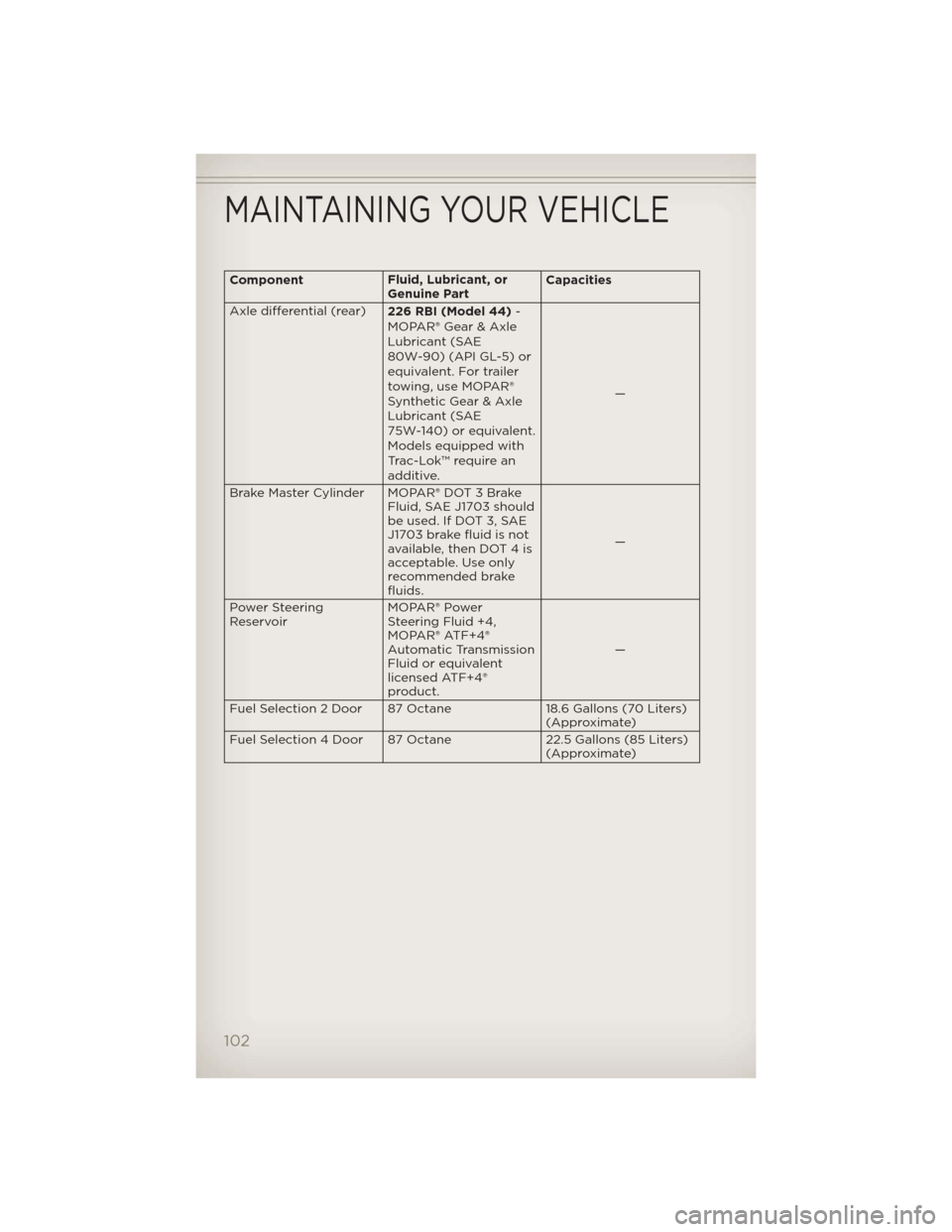
ComponentFluid, Lubricant, or
Genuine PartCapacities
Axle differential (rear)
226 RBI (Model 44)-
MOPAR® Gear & Axle
Lubricant (SAE
80W-90) (API GL-5) or
equivalent. For trailer
towing, use MOPAR®
Synthetic Gear & Axle
Lubricant (SAE
75W-140) or equivalent.
Models equipped with
Trac-Lok™ require an
additive.—
Brake Master Cylinder MOPAR® DOT 3 Brake
Fluid, SAE J1703 should
be used. If DOT 3, SAE
J1703 brake fluid is not
available, then DOT 4 is
acceptable. Use only
recommended brake
fluids.—
Power Steering
ReservoirMOPAR® Power
Steering Fluid +4,
MOPAR® ATF+4®
Automatic Transmission
Fluid or equivalent
licensed ATF+4®
product.—
Fuel Selection 2 Door 87 Octane 18.6 Gallons (70 Liters)
(Approximate)
Fuel Selection 4 Door 87 Octane 22.5 Gallons (85 Liters)
(Approximate)
MAINTAINING YOUR VEHICLE
102
Page 105 of 124
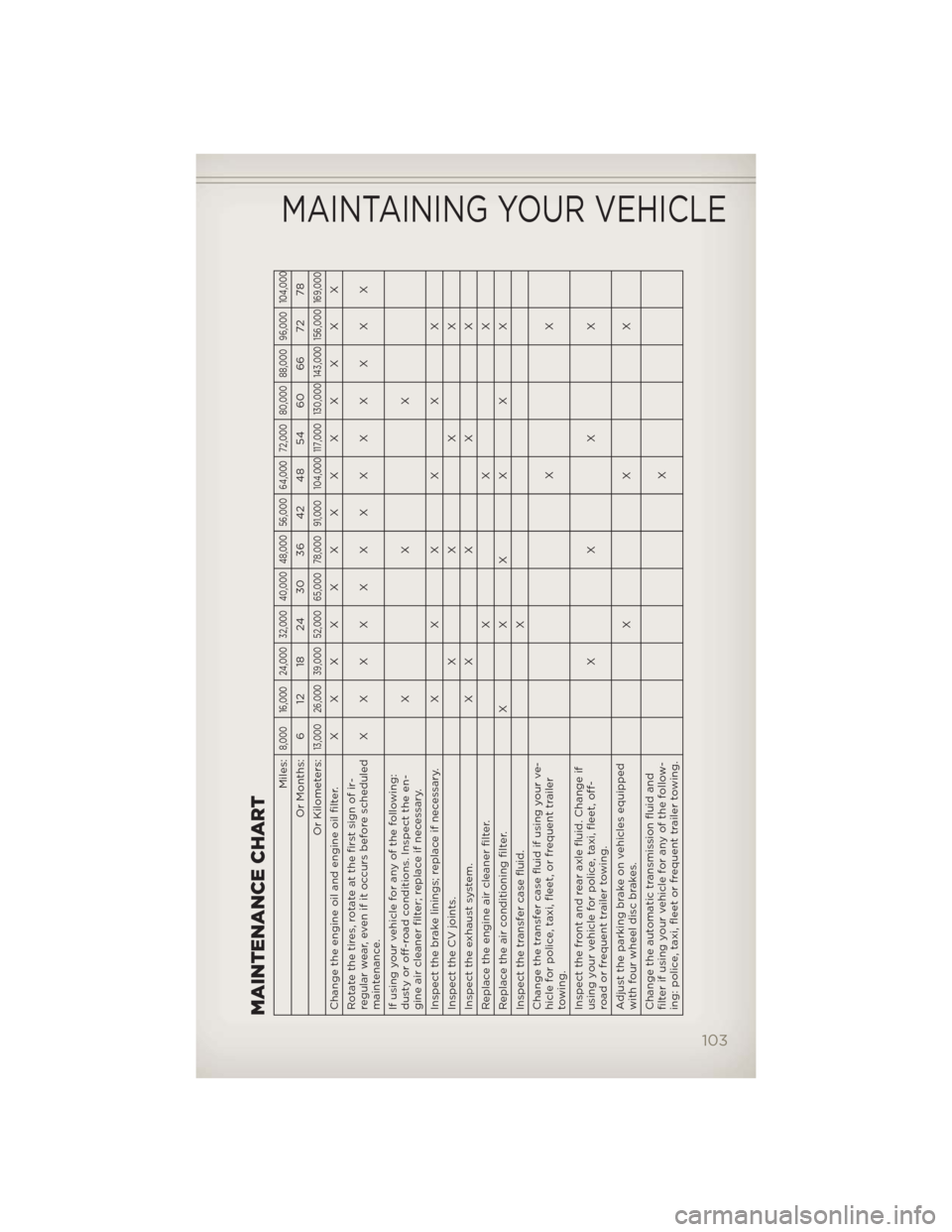
MAINTENANCE CHART
Miles:
8,000 16,000 24,000 32,000 40,000 48,000 56,000 64,000 72,000 80,000 88,000 96,000 104,000
Or Months: 6 12 18 24 30 36 42 48 54 60 66 72 78
Or Kilometers:
13,000 26,000 39,000 52,000 65,000 78,000 91,000 104,000 117,000 130,000 143,000 156,000 169,000
Change the engine oil and engine oil filter.XXXXXXXXXXXXX
Rotate the tires, rotate at the first sign of ir-
regular wear, even if it occurs before scheduled
maintenance.XXXXXXXXXXXXX
If using your vehicle for any of the following:
dusty or off-road conditions. Inspect the en-
gine air cleaner filter; replace if necessary.XXX
Inspect the brake linings; replace if necessary.XXXXXX
InspecttheCVjoints. XXXX
Inspecttheexhaustsystem. XXXXX
Replace the engine air cleaner filter. X X X
Replace the air conditioning filter. X X X X X X
Inspect the transfer case fluid. X
Change the transfer case fluid if using your ve-
hicle for police, taxi, fleet, or frequent trailer
towing.XX
Inspect the front and rear axle fluid. Change if
using your vehicle for police, taxi, fleet, off-
road or frequent trailer towing.XXXX
Adjust the parking brake on vehicles equipped
with four wheel disc brakes.XXX
Change the automatic transmission fluid and
filter if using your vehicle for any of the follow-
ing: police, taxi, fleet or frequent trailer towing.X
MAINTAINING YOUR VEHICLE
103
Page 106 of 124
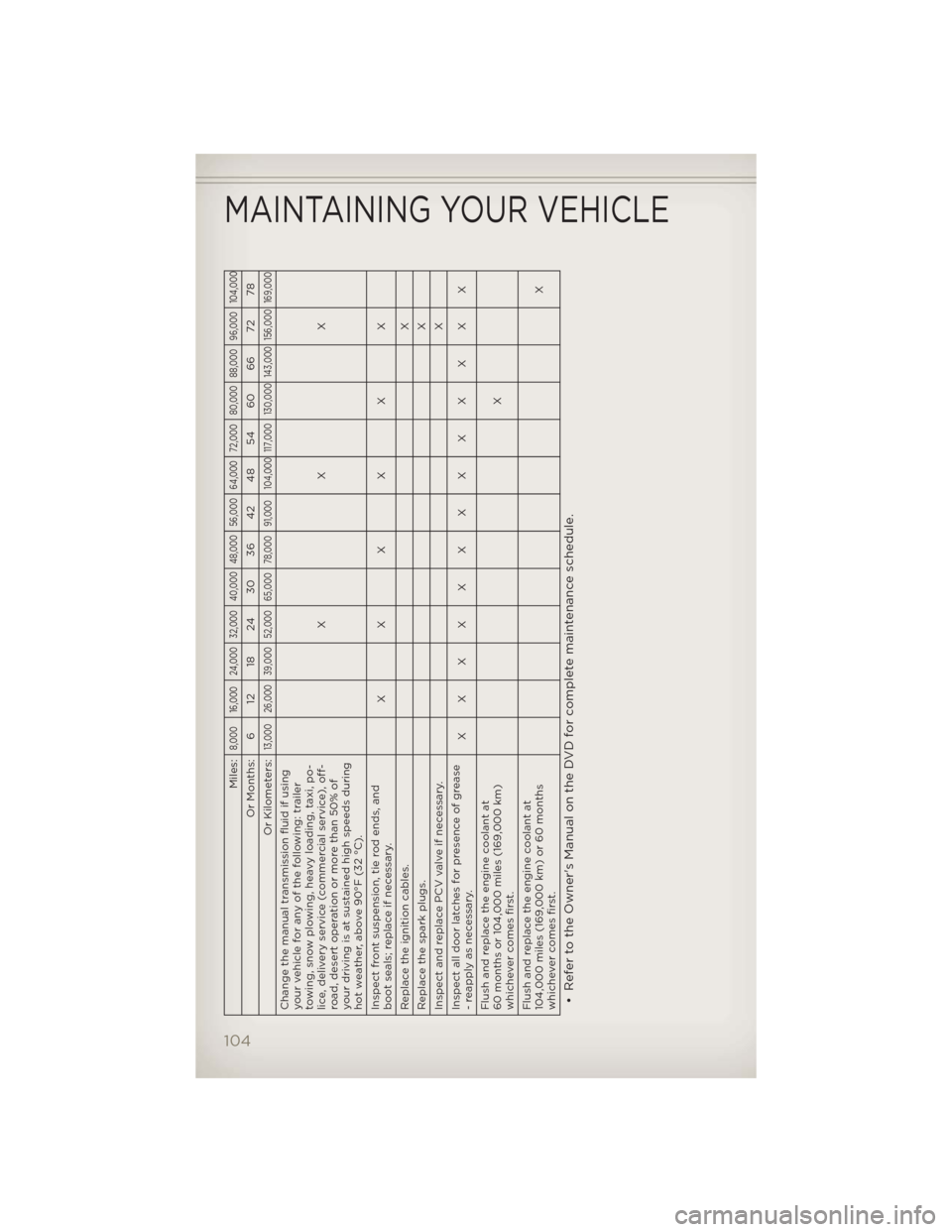
Miles:
8,000 16,000 24,000 32,000 40,000 48,000 56,000 64,000 72,000 80,000 88,000 96,000 104,000
Or Months: 6 12 18 24 30 36 42 48 54 60 66 72 78
Or Kilometers:
13,000 26,000 39,000 52,000 65,000 78,000 91,000 104,000 117,000 130,000 143,000 156,000 169,000
Change the manual transmission fluid if using
your vehicle for any of the following: trailer
towing, snow plowing, heavy loading, taxi, po-
lice, delivery service (commercial service), off-
road, desert operation or more than 50% of
your driving is at sustained high speeds during
hot weather, above 90°F (32 °C).XXX
Inspect front suspension, tie rod ends, and
boot seals; replace if necessary.XXXXXX
Replace the ignition cables.X
Replace the spark plugs.X
Inspect and replace PCV valve if necessary.X
Inspect all door latches for presence of grease
- reapply as necessary.XXXXXXXXXXXXX
Flush and replace the engine coolant at
60 months or 104,000 miles (169,000 km)
whichever comes first.X
Flush and replace the engine coolant at
104,000 miles (169,000 km) or 60 months
whichever comes first.X• Refer to the Owner's Manual on the DVD for complete maintenance schedule.
MAINTAINING YOUR VEHICLE
104